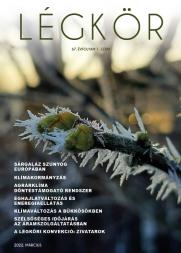LÉGKÖR - Quarterly Newsletter
Vol. 67, No. 1 * Pages 1–69 * March 2022
 |
|
 download [pdf: 23157 KB]
download [pdf: 23157 KB]
Assistance for adaptive management in forestry: the Agrárklíma decision support system
Mátyás Csaba, Bidló András, Czimber Kornél,Gálos Borbála, Gribovszki Zoltán, Führer Ernő, Illés Gábor, Borovics Attila
DOI:10.56474/legkor.2022.1.1 (pp. 4–11)
Mátyás Csaba, Bidló András, Czimber Kornél,Gálos Borbála, Gribovszki Zoltán, Führer Ernő, Illés Gábor, Borovics Attila
DOI:10.56474/legkor.2022.1.1 (pp. 4–11)
Eff ects of climate change on security of energy supply
Meszáros Péter
DOI:10.56474/legkor.2022.1.2 (pp. 12–13)
Meszáros Péter
DOI:10.56474/legkor.2022.1.2 (pp. 12–13)
The impact of the European Climate Decree on Hungarian climate governance
Huszár András
DOI:10.56474/legkor.2022.1.3 (pp. 14–19)
Huszár András
DOI:10.56474/legkor.2022.1.3 (pp. 14–19)
Mitigation of the climate change impacts in the agroecological practices of Hungarian farmers
Ujj Apolka, Jancsovszka Paulina, María Fernanda Ramos Díaz
DOI:10.56474/legkor.2022.1.4 (pp. 20–27)
Ujj Apolka, Jancsovszka Paulina, María Fernanda Ramos Díaz
DOI:10.56474/legkor.2022.1.4 (pp. 20–27)
Phytochemical response of beech (Fagus sylvatica L.) to the eff ects of projected climate change
Visiné Rajczi Eszter, Hofmann Tamás, Albert Levente, Mátyás Csaba
DOI:10.56474/legkor.2022.1.5 (pp. 28–33)
Visiné Rajczi Eszter, Hofmann Tamás, Albert Levente, Mátyás Csaba
DOI:10.56474/legkor.2022.1.5 (pp. 28–33)
Investigation of the past, the recent and future climate stability of yellow fever mosquito populations in Europe
Trájer Attila János
DOI:10.56474/legkor.2022.1.6 (pp. 34–41)
Trájer Attila János
DOI:10.56474/legkor.2022.1.6 (pp. 34–41)
Extreme weather events endangering the power supply III. section. Atmospheric convection: thunderstorms
Horváth Ákos, Simon André
DOI:10.56474/legkor.2022.1.7 (pp. 42–52)
Horváth Ákos, Simon André
DOI:10.56474/legkor.2022.1.7 (pp. 42–52)
LÉGKÖR - Quarterly Newsletter
A folyóirat nyomtatott változata megrendelhető a legkor@met.hu címen.
Kapcsolat: legkor@met.hu
SZERKESZTŐBIZOTTSÁG
SZERZŐI ÚTMUTATÓ
Kapcsolat: legkor@met.hu
SZERKESZTŐBIZOTTSÁG
SZERZŐI ÚTMUTATÓ









